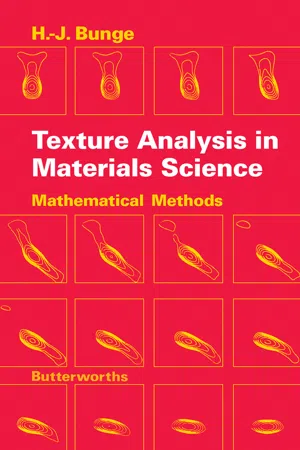
- 614 pages
- English
- PDF
- Available on iOS & Android
About This Book
Texture Analysis in Materials Science Mathematical Methods focuses on the methodologies, processes, techniques, and mathematical aids in the orientation distribution of crystallites. The manuscript first offers information on the orientation of individual crystallites and orientation distributions. Topics include properties and representations of rotations, orientation distance, and ambiguity of rotation as a consequence of crystal and specimen symmetry. The book also takes a look at expansion of orientation distribution functions in series of generalized spherical harmonics, fiber textures, and methods not based on the series expansion. The publication reviews special distribution functions, texture transformation, and system of programs for the texture analysis of sheets of cubic materials. The text also ponders on the estimation of errors, texture analysis, and physical properties of polycrystalline materials. Topics include comparison of experimental and recalculated pole figures; indetermination error for incomplete pole figures; and determination of the texture coefficients from anisotropie polycrystal properties. The manuscript is a dependable reference for readers interested in the use of mathematical aids in the orientation distribution of crystallites.
Frequently asked questions
Information
Table of contents
- Front Cover
- Texture Analysis in Materials Science: Mathematical Methods
- Copyright Page
- Table of Contents
- Preface
- Preface to the English Edition
- List of Symbols Used
- Chapter 1. Introduction
- Chapter 2. Orientation of Individual Crystallites
- Chapter 3. Orientation Distributions
- Chapter 4. Expansion of Orientation Distribution Functions in Series of Generalized Spherical Harmonics (Three-dimensional Textures)
- Chapter 5. Fibre Textures
- Chapter 6. Methods not Based on the Series Expansion
- Chapter 7. Special Distribution Functions
- Chapter 8. Texture Transformation
- Chapter 9. A System of Programs for the Texture Analysis of Sheets of Cubic Materials
- Chapter 10. Estimation of the Errors
- Chapter 11. Some Results of Texture Analysis
- Chapter 12. Orientation Distribution Functions of Other Structural Elements
- Chapter 13. Physical Properties of Polycrystalline Materials
- Chapter 14. Mathematical Aids
- Chapter 15. Numerical Tables
- Appendix 1: Tables 9.2—9.14
- Appendix 2: Listings of the ODF and Library Programs
- Appendix 3: Tables for Chapter 15
- Appendix 4: Graphic Representations
- Subject Index